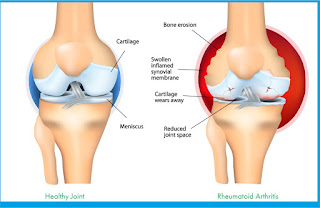OSTEOARTHRITIS KNEE PAIN
Symptoms & non-surgical Treatment
exclusively at PAIN
FREE ODISHA,Health Village Hospital, Bhubaneswar
by
DR. SHOVAN KUMAR RATH
M.D.(ANAESTHESIOLOGY),FIAPM(ISSP,IAPM), FIPP(NETHERLANDS)
Arthritis
is inflammation of one or more of your joints. Pain, swelling, and stiffness
are the primary symptoms of arthritis. Any joint in the body may be affected by
the disease, but it is particularly common in the knee.
Knee
arthritis can make it hard to do many everyday activities, such as walking or
climbing stairs. It is a major cause of lost work time and a serious disability
for many people.
Osteoarthritis
is the most common form of arthritis in the knee. It is a
degenerative,"wear-and-tear" type of arthritis that occurs most often
in people 50 years of age and older, but may occur in younger people, too.
In
osteoarthritis, the cartilage in the knee joint gradually wears away. As the
cartilage wears away, it becomes frayed and rough, and the protective space
between the bones decreases. This can result in bone rubbing on bone, and
produce painful bone spurs.
Osteoarthritis
develops slowly and the pain it causes worsens over time.
What Causes Knee Osteoarthritis?
The
most common cause of osteoarthritis of the knee is age. Almost everyone will eventually
develop some degree of osteoarthritis. However, several factors increase the
risk of developing significant arthritis at an earlier age.
•
Age: The ability of cartilage to heal
decreases as a person gets older.
•
Weight: Weight increases pressure on all
the joints, especially the knees. Every pound of weight you gain adds 3 to 4
pounds of extra weight on your knees.
•
Heredity: This includes genetic
mutations that might make a person more likely to develop osteoarthritis of the
knee.
•
Gender: Women ages 55 and older are more
likely than men to develop osteoarthritis of the knee.
•
Repetitive stress injuries: People with
certain occupations that include a lot of activity that can stress the joint,
such as kneeling, squatting, or lifting heavy weights, are more likely to
develop osteoarthritis of the knee because of the constant pressure on the
joint.
•
Athletics: Athletes involved in soccer,
tennis, or long-distance running may be at higher risk for developing
osteoarthritis of the knee. In fact, weak muscles around the knee can lead to
osteoarthritis.
•
Other illnesses: People with rheumatoid
arthritis, the second most common type of arthritis, are also more likely to
develop osteoarthritis. People with certain metabolic disorders, such as iron
overload or excess growth hormone, also run a higher risk of osteoarthritis.
SYMPTOMS
A
knee joint affected by arthritis may be painful and inflamed. Generally, the
pain develops gradually over time, although sudden onset is also possible.
There are other symptoms, as well:
•
The joint may become stiff and
swollen, making it difficult to bend and straighten the knee.
•
Pain and swelling may be worse
in the morning, or after sitting or resting.
•
Vigorous activity may cause
pain to flare up.
•
Loose fragments of cartilage
and other tissue can interfere with the smooth motion of joints. The knee may
"lock" or "stick" during movement. It may creak, click,
snap or make a grinding noise (crepitus).
•
Pain may cause a feeling of
weakness or buckling in the knee.
•
Many people with arthritis note
increased joint pain with rainy weather.
TREATMENT
Although
there is no permanent cure for arthritis, there are many treatment options
available to help manage pain and keep people staying active.
•
Lifestyle modifications [WEIGHT
LOSS/EXERCISE]
•
Physical therapy
•
Assistive devices.
•
Medications.
•
Surgical Treatment
•
Recent advances in non surgical
treatment [VISCOSUPPLEMENTATION/GENICULAR RF/ REGENERATIVE THERAPIES]
Stem Cell Therapy/ platelet rich plasma therapy for
Knee Injuries and Arthritis:
Stem
cells have an enormous capacity to differentiate into specialized tissues as
well as repair and regenerate the damaged cells. Stem cell therapies are being used to treat a
number of orthopaedic conditions like osteoarthritis,
rheumatoid arthritis, tennis elbow, head and shoulder pain, bone regeneration, injuries to ligaments or tendons. Stem
Cell therapy for knee has helped immensely in alleviating the pain and has
shown great results in the treatment of stuffed joint problems and arthritis as
it is less invasive than surgeries and safe.
RADIO FREQUENCY ABLATION
for genicular nerves (GNRFA) is a relatively new and lesser-known treatment
option that is proving effective for certain patients. GNREA relives arthritis knee
pain in maximum number of patients for duration of at least one year. In
present day scenario it is the best non-surgical procedure available.
Health Village
Hospital is the only Centre in Odisha to provided such treatment facility to
the people of Odisha since 10 years

No comments:
Post a Comment